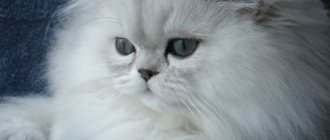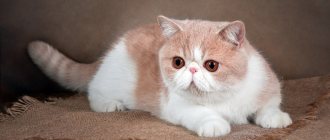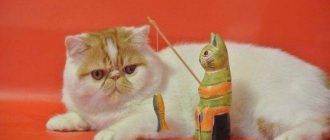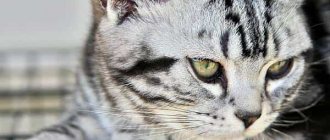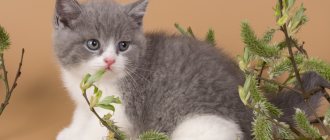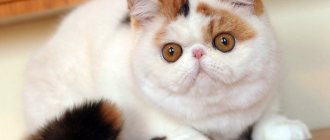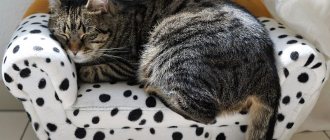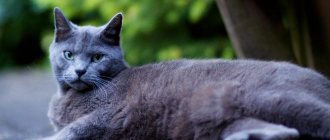Key facts
The exotic shorthaired breed is quite young, but has already earned popularity all over the world. Indeed, exotics are considered a good purchase due to their upturned nose, round funny face and bottomless eyes. Because of the texture of their fur, they are very similar to soft plush toys.
The country of origin of these individuals was the United States of America. Another name for the breed is Exotic Shorthair, and its abbreviated name is Exotic. Overseas breeders, as a result of crossing local and Persian breeds, achieved the birth of an amazing creature. The description of the exotic cat says that, in addition to the unusual exterior, the cats are peaceful, friendly and calm, which makes these cats suitable for keeping in any family.
Characteristics of an exotic cat: developed intelligence, curiosity, and quick wits; all this helps animals easily learn hygiene rules and even simple commands. The disadvantage of the breed is that exotic pets are in great need of human attention, so in the absence of it they suffer greatly.
The average life expectancy of an exotic cat is 12-15 years; proper care will help extend the years of your pet's life.
Breeding Features
Breeding exotic cats has its own nuances. The fact is that only 50–75% of kittens are born with short hair, the rest have long hair. Most felinological organizations, except for the CFA and GCCF, classify kittens with long hair born from exotic cats as the Persian breed.
Longhair exotic
Animals belonging to the show and breeding classes are used for breeding. Puberty in cats occurs at 8 months. Females who have already had several heats are allowed to crossbreed. It is customary to arrange a date for a couple on the territory of the gentleman. Cats do not immediately allow the groom to approach them; they need time to get comfortable and get to know their chosen one. Mating is considered successful if, 4 weeks after it, the female does not begin another estrus.
Origin story of the exotic cat
The exotic breed appeared in the 50s of the last century, and it happened completely by accident. The fact is that American breeders sought to develop a new color for the American Shorthair cat, as well as to make its body denser. For these purposes, they crossed an American with a Persian individual.
American breeders were unable to achieve the desired result, but received cute, almost doll-like offspring. From fluffy Persians, the kittens received thick plush fur and an unusual appearance. This is how representatives of a new exotic shorthaired breed appeared.
It was under this name that breeder Jane Martink presented the animals at the exhibition in 1966. Unfortunately, they did not receive quick recognition. Many breeders not only treated this breed poorly, but also prevented their breeding. The exotic cat turned out to be persona non grata at some exhibitions. Some breeders refused to breed Persian cats with exotics. Only Doris Walkinstick and Caroline Bussey saw the prospect of new animals and took part in their selection.
To improve the external qualities of pets, representatives of the Burmese breed, as well as Russian blue cats, were used. It was they who helped to consolidate the gene responsible for short, dense hair. Subsequently, such matings were stopped, mating was carried out only with Persians.
In 1990, breeders decided that all deviations from the Persian breed standard, namely the length and quality of the coat, belong to the Exotic Shorthair standard. From that time on, a triumphal procession of exotics began around the world. In Russia, the popularity of the breed is quite high, which explains the large number of nurseries in our country.
Cost of a kitten
Prices for kittens range from 15,000–70,000 rubles. The cost depends on the pedigree, titles of the parents and the class to which the animal belongs. The most expensive cats belong to the show class; they have no defects in appearance and receive high marks at exhibitions. By purchasing a pet-class kitten, you can save money. Such animals are not allowed for breeding, as they do not meet the standard, but they may well become a faithful friend for the family.
It is better to buy an animal from professional breeders, in registered nurseries. Their owners value their reputation, so they will not deceive customers. Breeders have all the documents for their cats, which can be studied before concluding a purchase and sale agreement. Kittens are adopted at the age of 12 weeks, when they are already litter box trained, vaccinated and socialized. The breeder will tell you how to care for the pet and what care products the new owner will need.
Similar cat breeds
British shorthair cat
Persian cat
American shorthair cat
Appearance:
Photo: Exotic Shorthair - Appearance
Head: Round when viewed from the front, without corners and without flat surfaces. A tiny snub nose, the upper border of the earlobe should be located no lower than the level of the lower eyelid. The stop should be located in the center of the muzzle, so that the distance from it to the chin and top of the head is the same (otherwise the illusion of a “round” head is lost). Powerful chin, lush cheeks, softly curving lips. The forehead, nose and chin lie in the same plane.
Eyes: huge, round, protruding, widely spaced at a distance the size of another eye and beyond. The sweet expression on the face largely depends on the eyes of an exotic cat - if they are set shallow, their expression will be childish and innocent, but if not, the cat can create a withdrawn, gloomy and even aggressive impression.
Ears: due to the shorter coat (than that of the Persians), the ears are more noticeable, so they should not be conspicuous and should preferably be small in size, wide and low apart.
Body: well balanced, harmoniously built, with heavy and powerful bones, with good muscle tone. Short hair cannot hide imperfections, so the body must be perfectly proportional. According to the standard, an exotic cat is a large to medium-sized cat. The body should be “square” in shape, proportional, and in no case long. The legs are short and powerful, the tail is short (proportionate to the body).
Coat: Medium length, dense and dense, soft, plush, with a rich undercoat that falls out completely during shedding.
What does an exotic cat look like?
Even a child can tell what an exotic cat looks like, the breed is so popular. In the photo, the exotic cat looks like a plush toy, but its personality doesn't quite match its appearance.
Muzzle
The exotic head is powerful and round in shape. The skull has wide, strong bones. The chin is strongly developed and has a round shape. The cheeks are very dense and fleshy. The jaws are strong and wide.
The eyes are round and large in size. They are located on the same line, but quite far from each other. The eye color of Persian cats is usually copper, dark copper, orange or yellow; in chinchillas – green, emerald green; Blue eye color is found in white cats and is required for color-point cats. The nose, paw pads, and whiskers correspond to the main color.
The ears are small, neatly round in shape. They are located low and also slightly tilted forward.
The pet's nose is very wide, but short and strongly turned up. The lobe is located almost between the eyes.
Body type
The general impression of a soft toy that resembles an exotic animal is deceptive. In fact, cats have a massive body, strong and slightly heavy bones. The body size is medium-sized with a broad chest and massive shoulders. The body itself is squat, with strong muscles and almost no fat. Varieties of exotic cats are not distinguished by body type or face shape.
The front and hind limbs of the animal are short, with strong bones. When looking at the cat, you can see that they are standing straight, parallel to each other. The hocks of this handsome plush are large, round in shape. There are 5 toes on the front paws, and 4 on the hind paws.
The tail of exotics is shortened, without bends. When at rest, it is located below the back.
Coat and color
The fur of an exotic cat is thick, of medium length, with a dense undercoat. It feels very soft and plush to the touch.
Exotic cats have the greatest variety of colors compared to other breeds. There are many varieties of recognized exotic cat colors:
- solidas, or solid colors from white to black, also include lilac, chocolate or fawn;
- tortoiseshell cats with white spots;
- patterned colors such as tabby or merle;
- color points are seal point, blue point, red point, cream point;
- tipping colors - chinchillas (silver, golden, cameo), as well as shaded, veiled.
Various combinations of colors and patterns make choosing a pet very difficult.
Description exotic
Colors: variety of palettes
Among the colors there are monochromatic ones - gray, white, black, red and beige, smoky. And also a mixture of colors - striped marble, a mixture of white and black (the cat looks like a Japanese bobtail in color), tortoiseshell, where black and red shades are mixed. There are red tabbies that have a pronounced red stripe on their back. Striped exotics combine beige and brownish colors.
What does a classic cat look like?
Disqualification is provided for those animals that have a curvature of the tail, strabismus, deformation of the skull, asymmetrical muzzle, or malocclusion. The description of the breed is shown in the table:
| Body part | Characteristic |
| Body | Massive, muscular, heavy bone |
| Chest developed, wide | |
| Head | Large, round |
| Snub nose, pronounced cheeks | |
| Ears | Small, pyramidal, directed slightly forward |
| Eyes | Round, wide open, slightly convex |
| Paws | Thick, proportional, short |
| Tail | Short, well furred |
| Leather and wool | The smooth-haired cat has short, plush fur that lies close to the body. |
| Long-haired cats have long, thick, flowing fur. | |
| Both species have a thick undercoat |
Character of an exotic cat
The character of an exotic cat matches its pleasant appearance, but not one hundred percent. She successfully combines good nature and tact with affection for a person.
The domestic exotic sincerely loves all family members, but he will feel the greatest devotion to the one whom he considers his master. It is from him that the pet wants to receive maximum attention, and is also most sad during his absence. In general, you should not leave your cat alone for a long time. He will become very sad, he will have a grudge against his owner.
Despite the fact that exotics seem clumsy, they are quite energetic and active. It is important for pet owners to remember that due to excessive curiosity, they sometimes end up in unpleasant situations or even harm themselves. You should not leave cats alone near open windows or balconies in an apartment, as the innate hunting qualities of these animals can make them rush after a fly, butterfly, or bird.
Short-haired cats show almost no signs of aggression towards other creatures. They calmly accept excessive affection from small children, tolerate their pranks, and sometimes don’t mind playing ball with them or running races. Exotics remain playful creatures until old age, but their level of activity decreases slightly with age.
Plush creatures get along well with other pets. They do not try to take a leading position, but they will not act as subordinates either. They try to remain neutral, preferring to observe everything from the outside.
Reviews about exotic cats
Owners speak of their pets as exceptionally gentle and good-natured creatures. According to them, these animals are very quiet, moderately playful, inquisitive and friendly. They will never rush at a person or offend him. Cats are clean and do not smell. Pets show interest in everything new - they strive to touch unfamiliar objects with their paws and smell them. Reviews about the breed are only positive.
Those who want to get an exotic cat need to be prepared to give it a lot of attention. If the work involves business trips, it is better to choose another breed, since exotics have a hard time withstanding separation from a person.
Raising an exotic cat
Exotic shorthair cats are highly intelligent and therefore easy to train. Raising pets begins from the first days of their appearance in the house. The main thing is to accustom the kitten to the tray and scratching post. As a rule, there are no problems with this, because smart exotics quickly remember the necessary rules of behavior.
A toilet with a comfortable filler is installed in a quiet place so that the baby can do his business without being distracted by external irritants. At first, you need to put him in the tray at the first signs of anxiety and sniffing the corners. It is worth holding the kitten there for several minutes, not forgetting to stroke it. This way he will not have a feeling of fear or hostility.
You can teach him to use a scratching post using a special solution from a pet store. It is simply sprayed onto the surface. You can use valerian tincture for these purposes.
Reviews from owners of exotic pets indicate that they are quite capable of following basic commands and also quickly learn prohibition words. They understand well the timbre of the voice or intonation of the owner. Therefore, you should not shout at the cat or raise your hand to it. Bullying will harm your pet's mental and physical health.
Looking for an exotic cat? Find your pet from 1 offer As a gift
Education and training
Raising or training this cat is quite easy. These are smart animals that respect their owner, observing the rules of behavior established by him. They quickly get used to the tray and are not inclined to misbehave, especially if their upbringing began in childhood.
With enough attention and time, they can be taught simple tricks and commands. This requires patience. If the animal fulfills the command correctly, it must be rewarded. Rudeness or physical force can destroy the trust between a person and an animal.
Shorthair exotic.
Exotic cat health
Possible diseases
Exotics are a human-bred breed, that is, they have not undergone natural selection. They are characterized by the same genetic diseases as their closest relatives - Persian cats. Therefore, the health of an exotic cat must be controlled by the owner.
The characteristic structure of the muzzle causes problems associated with disturbances in the shape of the nasolacrimal duct. This provokes diseases of the eyes and respiratory system. Pets often suffer from a runny nose due to hypothermia and exposure to drafts. Inflammation of the lacrimal glands leads to the development of conjunctivitis, and in the future it worsens exotic vision.
The oral cavity and teeth are also susceptible to the development of infectious diseases. The most common are gingivitis, stomatitis, and periodontal disease. This can be avoided if you carefully take care of the health of your cat's teeth and gums. Some animals experience abnormal development of the lower jaw. This pathology causes difficulty eating.
Unbalanced nutrition and overfeeding lead to the development of obesity in the pet. Problems with excessive weight provoke disturbances in the functioning of the animal’s cardiovascular system. Food allergies occur when food from the host’s table is overused.
For prevention, it is necessary to carry out routine vaccination of the cat. The first vaccinations are given at the age of 8 weeks, then at 12 weeks. An adult is vaccinated annually. Veterinarians offer medications for a whole range of infectious diseases: rabies, herpes, hepatitis, calcivirosis, distemper and some others.
Regular examination by a specialist, timely vaccinations, proper care and a balanced diet will help maintain the health of your exotic plush for many years.
Health and disease of the breed
The exotic Persian cat has inherited a number of diseases to which Persians are predisposed.
One of the most common problems is problems with the eyes, namely increased levels of tearfulness. The nasolacrimal duct is shorter in exotics than in other cat breeds. It is necessary to remove these contaminants every day; if this procedure is not carried out, there is a risk of conjunctivitis.
They often suffer from colds, gum inflammation, and kidney problems. Anatomically, they have a curved lower jaw, which makes it difficult for them to eat. From their Persian relatives, exotics acquired a tendency to certain diseases.
Polycystic kidney disease develops with a probability of up to 80% if this disease was diagnosed in one of the kitten's parents. Another disease characteristic of the breed is cardiomyopathy. With this pathology of the heart, the left ventricle suffers. Symptoms of the development of the disease are:
- frequent shortness of breath;
- pallor of mucous membranes;
- fatigue.
Exotic kittens may not show any signs of these diseases at an early age. The lifespan of this breed is on average 13-14 years, but there are individuals that live up to the age of 18 years.
Reproductive health
Exotic cats become fully physically developed by the age of one and a half years. Only then do owners begin to think about breeding a pet. Only purebred individuals should be considered. Before the procedure, you need to conduct an examination with a veterinarian, who must make sure that the future parents do not have diseases.
Pregnancy should be under the supervision of a doctor. You should increase your cat's nutritional intake and give her vitamin and mineral complexes recommended by your veterinarian. After 65 days, an average of 4-6 kittens are born. Childbirth usually takes place without complications, but to avoid problems, the presence of a doctor is advisable. Exotics become very sensitive parents.
Sterilization and castration are recommended until the age of one. This will help prevent complications and significantly improve your pet's standard of living.
Vaccinations and antiparasitic treatment
To prevent possible infection with infectious and viral diseases, exotic shorthairs are regularly vaccinated. The complex drug stimulates the production of immunity:
- to calcivirus;
- rhinotracheitis;
- panleukopenia.
The first vaccination for an exotic shorthair is given at the age of 7-8 weeks. After 4 weeks, the cat is vaccinated against the same diseases and against rabies. Subsequently, the exotic is vaccinated annually.
To protect a cat of this breed from diseases carried by fleas and worms, it is periodically subjected to antiparasitic treatment. Anthelmintic drugs for exotic shorthairs are given 2 times a year with mandatory repetition after 10-14 days.
A cat of this breed is protected from fleas using special drops and shampoos. And if an exotic shorthair is outdoors, an anti-parasitic collar is additionally put on it.
Features of feeding and diet
The healthy development of a pet is impossible without adequate nutrition. We must not forget about the tendency of exotic animals to overeat and obesity, so it is important to take into account not only the nutritional norm, but also its balance.
The cat menu can be of three types:
- natural;
- dry;
- mixed.
Each of them has its own characteristics. For example, when offering industrial food to your pet, you cannot save money. Only premium and super-premium products contain all the microelements and vitamins necessary for proper development. Dry and wet food at a cheap price category causes irreparable harm to the health of exotic animals. There are known cases of animal death due to harmful components contained in dry food from unscrupulous manufacturers.
Natural nutrition requires the owner to follow strict rules for organizing the pet’s diet. Most of the menu should consist of low-fat meat products: rabbit, chicken, beef, veal, lamb. Twice a month you can pamper your exotic with sea fish in the form of boneless fillets, as well as offal.
Porridge cooked in meat broth is also useful to include in the diet of exotic breed cats. Experienced breeders prefer oatmeal, buckwheat and rice. It is useful to mix them with pureed vegetables. For example, eating pumpkin or carrots for animals will help avoid problems with intestinal function.
Complementary feeding for one-month-old kittens begins with low-calorie fermented milk products. It is necessary to offer the baby cottage cheese, and once a week - a boiled chicken egg. Kittens are given low-fat milk, but it is not advisable for adults.
You cannot offer cats food from the owner's table, and the following are also harmful to them:
- sweets;
- pork;
- tubular bones;
- bony river fish;
- spicy, salty and smoked foods.
A mixed diet involves alternating dry or wet industrial food and natural food. We must not forget about the exotic drinking regime. Clean, fresh water should always be in your pet's bowl. If a cat eats ready-made food, it needs more water.
How many times to feed your pet depends on its age and weight. For example, a kitten from 1 month to 4 months is fed at least four times a day. By 6 months, the number of feedings is reduced to three times. From six months onwards they switch to a two-time feeding regimen.
Castration and sterilization
If the cat is not intended for breeding, it is better to spay or sterilize the animal. During castration, the reproductive organs are removed, in whole or in part. A cat's testicles are removed; in a cat with partial castration, only the ovaries; in a complete castration, the uterus is removed. However, recently, partial castration has been offered less and less due to the risk of developing pathologies in the uterus that began before castration. During sterilization, nothing is removed, but the spermatic cords of the cat or the ducts of the cat are ligated.
In this case, the animals retain the ability to mate without producing offspring. Typically, sterilization is practiced in nurseries.
This procedure is sometimes necessary for professional felinologists and owners of purebred catteries in their breeding work. Cats are capable of giving birth several times a year, and male cats are capable of demanding and mating cats with virtually no breaks. Therefore, to solve such problems, sometimes a sterilized cat is kept in the cat group. But owners of ordinary domestic cats and male cats do not need sterilization, and their pets need to be castrated.
Maria Epifanova
Magazine "FRIEND" No. 06(08) June 2004
Experienced veterinarians and breeders recommend castrating exotic cats at the age of 7–9 months.
Caring for your pet after surgery
Caring for a cat or an exotic breed is no different from caring for animals of other breeds. On the first day after surgery, it is necessary to monitor the pet’s condition, provide it with warmth, peace and absence of contact with other animals, if any.
The animal after surgery requires special attention
During the postoperative period, the animal experiences:
- Dry eyes. When anesthesia is administered, cats' eyes do not close; they remain open. During the operation, the veterinarian closes the animal's eyelids from time to time so that the conjunctiva is moistened with tears. Until the cat recovers from anesthesia, the owner will have to do this. In order to properly care for your pet's eyes, you need to buy tetracycline eye ointment or antiseptic drops. After the pet has recovered from anesthesia, there is no need to close his eyes; he will do this on his own. There are times when an animal lies for a long time with its eyes open, then it is necessary to drip saline solution into the eyes, this will save them from dryness.
- Low body temperature. The usual cat temperature is 37.5 – 39.0 degrees Celsius. In the postoperative period, the temperature can drop to 36.5 - 37.0 degrees. The cat should be placed on a warm bedding and covered with a warm blanket. In extreme cases, you can warm it with a heating pad. To normalize blood circulation, you need to rub the ears and paws.
- Unsteady gait. This is due to the relaxation of muscles during the application of anesthesia. On the first day, you should better monitor your pet so that he does not climb to any height, otherwise he may not be able to hold on and fall.
- At first, the cat needs painkillers. If your pet is silent, this does not mean that he does not feel pain. Most animals silently endure pain. They completely refuse food and are in a motionless position. Their pupils, as a rule, are dilated and concentrated. The gaze is fixed on one point.
The owner's actions in the postoperative period:
- Every day it is necessary to examine the groin area and check for bleeding;
- In order for the sutures to heal better, they are treated with hydrogen peroxide and brilliant green twice a day; you can also lubricate the suture area with Levomekol ointment;
- During the rehabilitation period, the cat must be wearing a collar that will prevent the animal from licking the wound, as this can lead to the sutures coming apart and, accordingly, infection;
- The rehabilitation period is easier in the winter; if the operation was performed in the summer, then a five-day course of antibiotic therapy may be needed - it is better to be on the safe side than to treat the resulting infection later.
Care and maintenance
Due to some peculiarities of care and maintenance, the exotic cat is called the lazy Persian. This indicates their unpretentiousness, but not a lack of care at all.
Your pet's thick coat needs regular brushing. It is combed out at least twice a week using a special comb made of metal. Exotics are a very clean breed, so they carefully lick themselves. Therefore, it is necessary to regularly give them medications to remove hairballs from the stomach. Such medications are purchased from veterinary pharmacies and used strictly according to the instructions. They can be replaced with fresh grass.
The exotic needs to be bathed once a month. This is done in a non-slip basin with warm water using a special shampoo for short-haired cats. It is necessary to soap the animal twice, because the thick undercoat does not allow moisture to penetrate its skin well. After washing, the pet is wrapped in a large warm towel and left in a room away from drafts. Before water procedures, cotton wool is inserted into the cat's ears to prevent water from getting into them.
The exotic's eyes and nose need daily wiping. This is due to the unusual structure of its muzzle. The eyes are wiped with a dry cloth or cotton pad soaked in a special lotion. Once a week, the ears are cleaned of accumulated dirt using a cotton swab.
Exotics, like other domestic cats, have their nails trimmed. Do this twice a month, cutting off no more than 2 mm of the nail plate. For cutting, use small nail clippers and a regular nail file. If a cat walks on the street (lives in a private house), then the claws are cut less often, as they grind down on their own.
When an exotic kitten appears in an apartment, he needs to be given a quiet, warm place, equipped with a comfortable soft bed. To prevent the animal from feeling loneliness, it should not be placed far from people. In this case, he will be scared and lonely. Drafts are dangerous for the health of your plush pet, so you should close the vents or windows in a timely manner.
What to feed the exotic?
The animal's diet consists of high-quality feed and natural foods such as lean meat and vegetables.
An adult cat eats 80-100 g of high-quality food - “Bozita”, “Farmina”, “Trainer”, “Acana”. Brachycephalic pets can be fed with special food that has been developed, whose kibble is convenient for such breeds to grab. The food is supplemented with homemade food - lean meat, offal and fish fillets (no more than 1 meal per week), boiled vegetables (except broccoli and tomatoes), rice porridge.
Tips for choosing a kitten
When choosing a future pet, it is important to consider the purpose of its acquisition. When buying a baby as a companion or to participate in exhibitions, you should pay attention to the following points:
- soft, not bloated tummy;
- clean ears and eyes;
- teeth without yellow plaque;
- soft and dense fur.
Before buying, you need to observe the baby’s behavior. He must be active, inquisitive, playful. Fearfulness is characteristic only of adults, and in kittens it is a bad sign.
Exotic kittens are taken from the breeder at the age of three months. By this time, the baby should acquire a veterinary passport with notes on the routine vaccination. Also, by this age, exotics should have basic hygiene skills and have strong immunity due to maternal feeding. By this time they already know how to feed themselves. Therefore, it would be a good idea to inquire about the type of food the kitten is eating and the brand of litter for the trays.
The seller is obliged to provide documents on the pedigree of the parents upon the first request of the buyer. Ask to see the baby's mother, make sure she is in good physical and mental health. If exterior is important to you, then first familiarize yourself with the breed standards of an exotic cat or consult with an experienced owner.
How to choose a kitten
Exotic kittens endear you from the very first visit to a breeder or nursery. Little exotics resemble a beautiful plush toy. When choosing, you need to pay attention to the pedigree and parents, the state of his health. It is recommended to choose a reliable nursery that has many positive reviews, recommendations, and many years of experience working with the breed. Often, unscrupulous sellers, under the guise of exotics, offer British dogs with an admixture of the Persian breed. But mixed-breed kittens should cost less. There are different crosses of exotics:
- American exotic;
- exotic extreme;
- lop-eared exotic.
Crossing exotics with third-party breeds is prohibited, and buying such a kitten for the purpose of breeding threatens poor health and future offspring not meeting recognized standards.
How much does an exotic cat cost?
The exotic breed belongs to the middle price segment. The cost of kittens ranges from 15,000 to 70,000 rubles. Pricing is influenced by:
- pedigree;
- parents' title;
- the kitten belongs to a certain class.
The most expensive is the show class. Such cats do not have any appearance flaws. Pet class animals cannot take part in breeding work and are subject to mandatory sterilization. But this does not affect their character, loyalty and love for their owner. An exotic kitten of this class costs up to 7,000 rubles.
Interesting read: everything about the character and habits of Maine Coons.
Nicknames for exotic cats
A kitten of any breed should have a beautiful, understandable, but memorable nickname that will fully characterize it. The most common variants of nicknames for exotics are the following:
Table of popular names for cats and cats.
Cat and your apartment
Exotic kittens need warmth and comfort, so the animal should have its own small corner, a cat’s “house”.
You also need to pay attention to basic safety: put screens on the windows - this will help ventilate the rooms without risk to the animal, because due to the special structure of exotic cats, a fall often ends in death for them.
We hope that the exotic cat will become a true member of the family, bring warmth and comfort to your home, and live a long and happy life with you!
Appearance and character of exotics
An exotic is a large cat with powerful and strong bones.
The appearance must meet the following criteria:
- Torso. The skeleton is strong and heavy. The cat looks massive and squat.
- Limbs. Shorter than other cats, thick and powerful. The paws are round, bunched into a dense ball, and there are tufts of hair between the toes.
- Tail. Not long, well pubescent, thick at the base. The tip is slightly rounded.
- Head. Large, massive, round in shape. Exotics have a wide skull with a convex forehead. The cheeks are rounded, the nose is flattened.
- Ears. Triangular, wide set. They are small in size relative to the head, the tips are rounded.
- Eyes. Expressive, large. Widely spaced. The color of the iris should match the color of the coat.
The fur of exotic cats is plush to the touch, short and soft. It does not adhere to the body due to the thick undercoat.
Exotic fur has a plush feel to the touch.
The color can be anything except cinnamon (cinnamon color) and fawn (light beige). The breed is not hypoallergenic, so before getting a pet, you need to make sure there are no allergies.
Interesting! The weight of an adult exotic can reach 7-8 kg.
Exotic shorthairs are inquisitive and cheerful animals.
They have a soft and calm character, are happy to make contact, love affection, but at the same time they are unobtrusive and patiently wait for the owner to pay attention to them.
Be sure to read:
European Shorthair (Celtic cat): description of the breed, character, kittens, where to buy
The exotic looks closely at strangers for a long time , but if he likes the person, he will reciprocate the affection. These animals rarely show aggression.
Cats become very attached to their owners and need constant contact with them. They willingly accompany their owners on trips and tolerate long trips well. Their behavior resembles that of dogs.
Exotic shorthairs get along well with children and pets. They can live both in an apartment and in a private house.
In the area, the exotic cat prefers to lie on the grass and rest; such cats rarely catch mice.
Education and training
Exotics have developed intelligence and are able to remember simple commands.
Exotics have developed intelligence and are able to remember simple commands
They begin raising the baby immediately after he moves to a new home. During the training process, physical impact and aggression should be avoided.
Attention! It is necessary to communicate with an exotic person gently and patiently. Threats and intimidation will cause the kitten to permanently lose trust in its owner.
Education involves training your pet to use a scratching post and a litter box. The scratching post can be sprayed with valerian or catnip infusion so that the pet shows interest in it. If the animal begins to sharpen its claws on the carpet or furniture, it is immediately taken to the scratching post and praised if the pet has used it.
Filler is poured into the tray, and then the baby is placed in it and digging movements are made with the front paws. It is necessary to closely monitor the kitten and, as soon as it begins to look for a place to relieve itself, transfer it to the tray.
After the baby goes to the toilet, he is praised and treated with his favorite treat.
How long do exotics live?
The Exotic Shorthair is considered mature at the age of 2-2.5 years. With proper care, an animal of this breed will live even up to 20 years, but the average life expectancy is 12-15 years.
Estrus and mating
It is worth noting here that the number of matings does not affect the number of kittens, it all depends on the fertility of the cat.
Pregnancy proceeds without problems, but during the birth process, which begins after 63-66 days, the help of a veterinarian may be needed.
A pregnant pet should be fed 3-4 times a day with special food. Quite nutritious food.
A few days before the birth, you need to prepare a box and a soft blanket, which the expectant mother will use as a house.
Advantages and disadvantages
The exotic shorthair cat stands out due to such qualities as:
- toy appearance;
- low requirements for living conditions;
- good-natured and calm character;
- lack of aggression;
- suppressed hunting instinct.
Despite all the advantages, the exotic breed has its disadvantages:
- risk of genetic abnormalities;
- it is difficult for a cat to lick the thick plush cover;
- the need for constant eye hygiene.
Walking and exercise
Our pets are distinguished from their Persian ancestors by their activity, mobility, playfulness and ease of movement, while the given criteria do not lose their relevance with the age of the animal.
They are ready to play with anything: a ball, crumpled paper, even a simple ribbon will be used. However, as a rule, they do not play for long and prefer to spend all their “free time from work” lounging on a soft blanket.
Street walks are not at all necessary for them, but from time to time you can take your plush pet out into the yard on the grass. Don't forget the harness! Take your favorite treat for a walk so that the cat associates this process with something not only unusual, surprising and maybe even a little scary, but also very pleasant.
